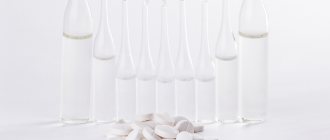Write a review
Reviews: 0
Manufacturers: Synthesis, Biochemist, Shandong Keyuan Pharmaceutical Co. ltd., ShanDong Weifang Pharmaceutical Factory
Active ingredients
- Benzylpenicillin
Disease class
- Bacterial meningitis, not elsewhere classified
- Corneal ulcer
- Acute and subacute infective endocarditis
- Bronchopneumonia, unspecified
- Bronchitis, not specified as acute or chronic
- Pyothorax
- Impetigo
- Acute peritonitis
- Local infection of skin and subcutaneous tissue, unspecified
- Cholangitis
- Soft tissue disease, unspecified
- Osteomyelitis, unspecified
- Lesion of the skin and subcutaneous tissue, unspecified
- Urinary tract infections during pregnancy
- Pleurisy
- anthrax
- Leptospirosis icteric-hemorrhagic
- Leptospirosis, unspecified
- Diphtheria, unspecified
- Scarlet fever
- Septicemia, unspecified
- Pulmonary actinomycosis
- Erysipelas
- Gas gangrene
- Syphilis, unspecified
- Gonococcal eye infection
- Gonococcal infection, unspecified
- Post-traumatic wound infection, not elsewhere classified
- Acute tonsillitis, unspecified
- Urinary tract infection without established localization
- Inflammatory diseases of the female pelvic organs, unspecified
Clinical and pharmacological group
- Not indicated. See instructions
Pharmacological action
- Antibacterial
- Bactericidal
Pharmacological group
- Penicillins
Similar drugs:
- Augmentin Oral tablets
- Tea tree DN Ointment for external use
- Augmentin Powder for suspension for oral administration
- Bactrim Oral suspension
- Dioxydin Mouth rinse solution
- Pancef Oral tablets
- Nifuroxazide (Nifuroxazide) Oral tablets
- Cifran OD Oral tablets
- Pancef Granules for the preparation of suspension for oral administration
- Augmentin ES Powder for oral solution
** The Drug Directory is intended for informational purposes only. For more complete information, please refer to the manufacturer's instructions. Do not self-medicate; Before starting to use the drug Benzylpenicillin sodium salt, you should consult a doctor. EUROLAB is not responsible for the consequences caused by the use of information posted on the portal. Any information on the site does not replace medical advice and cannot serve as a guarantee of the positive effect of the drug.
Are you interested in the drug Benzylpenicillin sodium salt? Do you want to know more detailed information or do you need a doctor's examination? Or do you need an inspection? You can make an appointment with a doctor - the Euro lab is always at your service! The best doctors will examine you, advise you, provide the necessary assistance and make a diagnosis. You can also call a doctor at home . Euro lab clinic is open for you around the clock.
** Attention! The information presented in this medication guide is intended for medical professionals and should not be used as a basis for self-medication. The description of the drug Benzylpenicillin sodium salt is provided for informational purposes and is not intended for prescribing treatment without the participation of a doctor. Patients need to consult a specialist!
If you are interested in any other drugs and medications, their descriptions and instructions for use, information about the composition and form of release, indications for use and side effects, methods of use, prices and reviews of drugs, or you have any other questions and suggestions - write to us, we will definitely try to help you.
BENZYLPENICILLIN SODIUM SALT
Directions for use and doses
Benzylpenicillin sodium salt is administered intramuscularly, intravenously, subcutaneously, locally.
Intravenously and intramuscularly:
for moderate disease (infections of the upper and lower respiratory tract, urinary and biliary tract, infection of soft tissues, etc.) - 4-6 million units/day for 4 administrations. For severe infections (sepsis, septic endocarditis, meningitis, etc.) - 10-20 million units/day; with gas gangrene - up to 40-60 million units/day.
The daily dose for children under 1 year of age is 50-100 thousand units/kg, over 1 year of age – 50 thousand units/kg; if necessary - 200-300 thousand units/kg, for “vital” indications - increase to 500 thousand units/kg. Frequency of administration: intramuscularly - 4-6 times a day, intravenously - 1-2 times a day in combination with intramuscular injections.
Subcutaneously
for infiltrating infiltrates at a concentration of 100-200 thousand units in 1 ml of 0.25-0.5% procaine solution.
In the cavity (abdominal, pleural, etc.)
a solution of benzylpenicillin sodium salt is administered to adults at a concentration of 10-20 thousand units per 1 ml, for children - 2-5 thousand units per 1 ml. Water for injection or 0.9% sodium chloride solution is used as a solvent. The duration of treatment is 5-7 days, followed by switching to intramuscular administration.
For eye diseases
Prescribe
eye drops
containing 20-100 thousand units in 1 ml of sterile 0.9% sodium chloride solution or distilled water. Inject 1-2 drops 6-8 times a day. The solution is used freshly prepared.
For ear drops or nose drops
solutions containing 10-100 thousand units in 1 ml of sterile 0.9% sodium chloride solution or distilled water are used. Administer 1-2 drops 6-8 times a day.
The duration of treatment with benzylpenicillin, depending on the form and severity of the disease, is 7-10 days.
Solutions are used immediately after preparation, avoiding the addition of other medications to them.
For intramuscular administration
add 1-3 ml of water for injection, 0.9% sodium chloride solution or 0.5% procaine (novocaine) solution to the contents of the bottle. The resulting solution is injected deep into the muscle.
When benzylpenicillin is diluted in a procaine solution, cloudiness of the solution may be observed due to the formation of benzylpenicillin procaine crystals, which is not an obstacle to intramuscular and subcutaneous administration of the drug.
For intravenous jet administration
a single dose (1-2 million units) is dissolved in 5-10 ml of sterile water for injection or 0.9% sodium chloride solution and administered slowly over 3-5 minutes.
For intravenous drip administration
2-5 million units are diluted in 100-200 ml of 0.9% sodium chloride solution or 5-10% dextrose solution and administered at a rate of 60-80 drops/min. When administered dropwise to children, a 5-10% dextrose solution (30-100 ml depending on the dose and age) is used as a solvent.
For subcutaneous administration
the contents of the bottle are diluted in 0.25-0.5% procaine solution: 500 thousand units in 2.5-5 ml, 1 million units in 5-10 ml, respectively.
For intracavitary administration
the contents of the bottle are diluted in 0.9% sodium chloride solution or in water for injection: adults - 500 thousand units in 25-50 ml, 1 million units in 50-100 ml, respectively; children - 500 thousand units in 100-250 ml, 1 million units in 200-500 ml, respectively.
Eye drops
should be prepared ex tempore: the contents of the bottle are diluted in a 0.9% solution of sodium chloride or distilled water: 500 thousand units in 5-25 ml, 1 million units in 10-50 ml, respectively.
Ear drops and nasal drops:
the contents of the bottle are diluted in 0.9% sodium chloride solution or distilled water: 500 thousand units in 5-50 ml, 1 million units in 10-100 ml, respectively.
Side effects
candidiasis of the oral cavity and/or vagina , may occur .
From the gastrointestinal tract, a feeling of nausea , diarrhea , and sometimes vomiting .
On the part of the central nervous system, especially when using high doses of the drug or when performing endolumbar injections, the formation of neurotoxic phenomena , such as an increase in reflex excitability, convulsions , nausea, symptoms of meningism , vomiting, coma .
The observed allergic manifestations included fever , skin rash and/or rash on mucous membranes, urticaria , joint pain, angioedema , eosinophilia anaphylactic shock , which can be fatal is also possible .
Pharmacodynamics and pharmacokinetics
Benzylpenicillin is a biosynthetic antibiotic and belongs to the group of penicillins . The bactericidal effectiveness of the drug is manifested due to its ability to inhibit the synthesis of bacterial cell .
The effect of the drug is detrimental to gram-positive microorganisms: staphylococci , causative agents of diphtheria and anthrax , streptococci ; gram-negative bacteria: pathogens of gonorrhea and meningococcal infection ; spore-forming anaerobic rods; as well as spirochetes and actinomycetes .
Strains of staphylococci that produce penicillinase are not sensitive to the effects of benzylpenicillin .
When the drug is administered intramuscularly, TCmax in plasma is observed after 20-30 minutes. Binding to plasma proteins occurs by 60%. The antibiotic has good penetration into tissues, biological fluids and organs of the human body, with the exception of cerebrospinal fluid , prostate gland and eye tissues, and passes through the BBB . Excretion is carried out in unchanged form by the kidneys. T1/2 fluctuates between 30-60 minutes, with kidney pathologies it can increase to 4-10 hours or even more.
Price, where to buy
The price for benzylpenicillin sodium salt, 1,000,000 units, is 6-7 rubles per bottle.
- Online pharmacies in UkraineUkraine
- Online pharmacies in KazakhstanKazakhstan
PaniPharmacy
- Benzylpenicillin bottle Benzylpenicillin sodium salt powder for injection 1000000IU Ukraine, Kievmedpreparat OJSC
11 UAH.order
show more
special instructions
Benzylpenicillin is prescribed with extreme caution to patients with kidney pathologies , heart failure , allergies (especially drug allergies ), as well as hypersensitivity to cephalosporins (due to the possible formation of cross-reactions).
In case of zero effect of therapy carried out over 3-5 days, the possibility of combination with other drugs or the prescription of other antibiotics .
During treatment fungal superinfections , and therefore it is advisable to use antifungal agents .
It should be remembered that early interruption of treatment with benzylpenicillin or its use in subtherapeutic doses contributes to the formation of resistant bacterial strains .
Indications for use
Benzylpenicillin is indicated for the treatment of diseases that were caused by microorganisms sensitive to its effects:
- focal/lobar pneumonia ;
- syphilis;
- pleural empyema;
- scarlet fever;
- sepsis;
- diphtheria;
- septicemia;
- erysipelas;
- pyemia;
- anthrax;
- septic endocarditis (subacute and acute);
- actinomycosis;
- meningitis;
- ENT infections;
- osteomyelitis;
- gonorrhea;
- biliary and urinary tract infections;
- blenorrhea;
- angina;
- infections of mucous membranes and soft tissues;
- purulent skin infections;
- purulent-inflammatory infections in gynecologists.
Overdose
In case of overdose of benzylpenicillin, its toxic effect on the central nervous system was noted (mainly when administered endolumbarally). The observed symptoms were manifested by reflex agitation , nausea, headaches , myalgia , vomiting, convulsions , meningism , arthralgia, coma .
In this situation, further injections are stopped and symptomatic treatment is prescribed, including hemodialysis . In this case, special attention is paid to the water-electrolyte state.
Reviews
On various Internet resources you can find both negative and positive reviews about benzylpenicillin sodium salt . When the drug is used against microorganisms , the treatment almost always shows good results and, on the contrary, when using Benzylpenicillin to destroy strains of bacteria , at best, it is wasted. In this regard, for any bacterial infection causative agent before starting therapy and only then prescribe an antibiotic .

